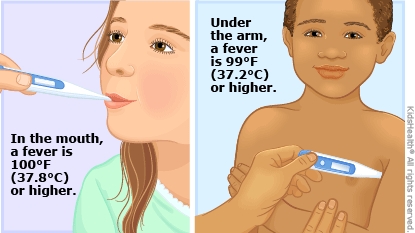Fevers aren't dangerous or bad for children. They can help the immune system fight infection. The health care provider examined your child carefully and did not find a serious cause for the fever during this visit. But symptoms can change, so keep watching your child carefully.



Your child:

Your child:

What causes fever? In most cases, fever in a child is due to a viral infection (such as a cold or a stomach bug). But fever can also be caused by a bacterial infection, which needs antibiotics.
What temperature is considered a fever? Temperatures taken in different ways can give different readings. You should know the number that is a fever for the type of measurement you are taking:
| Type of measurement | Where you take the temperature | When is the temperature a fever? |
| Oral | Mouth | 100°F (37.8°C) or greater |
| Temporal Artery | Forehead | 100.4°F (38.0°C) or greater |
| Ear | Ear | 100.4°F (38.0°C) or greater |
| Axillary | Armpit | 99°F (37.2°C) or greater |
Can a high fever harm my child? No. Only high body temperatures caused by heat coming from outside the body can be harmful (such as when a child is left in a hot car). A few children have seizures during a fever (febrile seizures). These are scary to see, but they do not cause brain damage or mean a child has a seizure disorder. Most kids who have febrile seizures grow out of them. High fevers don't necessarily mean an illness is serious or that antibiotics will be needed. How your child is feeling is more important than how high the fever is.
Does a fever always have to be treated? Not always. If your child seems well, is alert, is drinking, and is acting normally, there’s no need to give medicine for fever. If your child seems cranky, tired, and uncomfortable, reducing the fever can help make your child feel better.